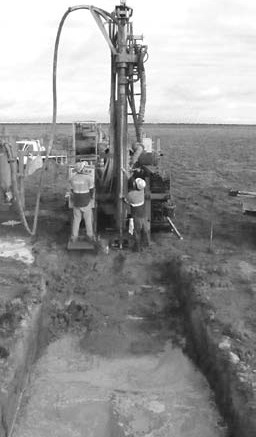Vancouver — A month after the government in Western Australia lifted a ban on uranium mining, Mega Uranium (MGA-T, MGAFF-o) released a preliminary economic assessment for its Lake Maitland project that shows a strong rate of return.
The study investigated the economics of producing 1.65 million lbs. of U3O8 annually. Capital cost to develop the project came in at US$85.1 million and operating costs averaged out to US$16.6 per lb. U3O8. The project generates a net present value (NPV) of US$181.4 million and an internal rate of return (IRR) of 43.4%.
This preferred development case assumes a sale price of US$75 per lb. U3O8. If the U3O8 price drops to US$60, the NPV falls to US$99.7 million and the IRR to 30.8%; if the price climbs to US$90 per lb., the NPV rises to US$263.1 million and the IRR to 54.3%. (At presstime, the spot price was US$44 per lb. U3O8)
All cases assume a 90% leaching recovery rate, a long-term Australian dollar exchange rate of US80, an 8% cost of capital, a 30% corporate tax rate, and a 10% NPV discount rate.
Lake Maitland is home to a calcrete- style deposit that occurs in a single coherent layer hidden under 1.5 metres of cover, making the deposit amenable to low-cost open-pit mining. The overburden and ore are soft, which means drilling and blasting will not be required. Mega is aiming to get the project into production in 2011.
Mega completed a resource estimate for Lake Maitland in 2007 that pegged inferred resources at 16.6 million tonnes grading 0.5% U3O8, using a 0.2% U3O8 cutoff grade. The new study is based on the inferred resource and so does not include data from the 532 air-core and 42 sonic-core infill holes or the 229 air-core expansion holes.
Definitive feasibility studies will now focus on various processing, engineering, and infrastructure options with a view to enhancing the project economics. Mega plans to investigate the impact of using a continuous miner, beneficiating ore prior to leaching, and possibilities around using existing infrastructure.
Australia holds 23% of the world’s known uranium resources with 1.24 million tonnes of uranium oxide defined, but the ban limited the number of operating mines to just three. The ban is now lifted in Western Australia only, where the Liberal and National parties formed a coalition to beat out the Labor Party. It’s the first non-Labor government for any of Australia’s eight states in the past decade.
It’s estimated that Western Australia holds 7-10% of the country’s uranium and that Australia could supply 36% of the world demand, up from the current 23%.
Mega owns or is earning in on many uranium projects. Near Lake Maitland in Western Australia sits Mega’s Ben Lomond deposit, which the company wants to bring into production soon after Lake Maitland.
In the Wenecke uranium district of the Yukon, Mega is exploring the Igor iron-oxide copper-gold-uranium project with joint-venture partner Cash Minerals (CHX-V, CHXMF-o). In the western Athabasca basin of Saskatchewan, Mega is earning a 55% interest in Forum Uranium’s (FDC-V, FDCFF-o) Maurice Point property by spending $8 million over three years. Mega is also earning in on CanAlaska Uranium’s (CVV-V, CVVUF-o) Poplar project in the basin.
The company has grassroots property interests in Colombia and, through its recent acquisition of Energentia Resources, holds the Berlin deposit there, which contains a historical resource of 38 million lbs. U3O8. Mega is also exploring in Argentina.
Mega shares lost 8 on news of the Lake Maitland study to close at 98 apiece. The company has a 52-week trading range of 81- $5.72 and has 187.5 million shares issued.


Be the first to comment on "Lake Maitland shows strong economics for Mega Uranium"